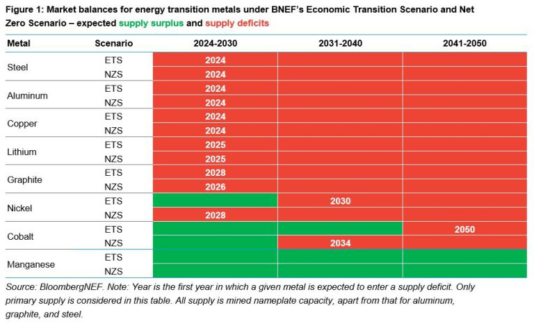A new report from BloombergNEF (BNEF), published on 3 October, shows that the global mining industry needs investments of around $2.1 trillion by 2050 in order to scale up extraction of key metals to the levels needed for the energy transition away from fossil fuels.
Of immediate concern is the supply of several key metals, including copper, lithium and aluminium, that face supply deficits within this decade – “some as soon as this year”, according to the latest Transition Metals Outlook report.
The wind industry relies on the supply of several key raw materials such as copper[1], which is used extensively both inside wind turbines and in the wider infrastructure to transport the electricity they produce.
The report bases its forecasts on two scenarios previously mapped by BNEF, including an “economic transition scenario” (ETS) assuming no additional policy support for reducing carbon emissions, and a “net-zero scenario” (NZS) that assumes new policies to help the world achieve net zero carbon emissions according to global targets.
In both scenarios, copper faces a supply deficit between 2024 and 2030, BNEF suggests.
Similar supply deficits in both potential scenarios are forecast for other key metals, including those needed by the wind industry such as steel and aluminium, between 2024 and 2030.
“The prolonged deficit of these metals will lead to higher prices for raw materials, which increases the cost of clean energy technologies. High costs could slow their adoption, and the energy transition at large,” Kwasi Ampofo, head of metals and mining at BNEF and lead author of the report, said.
Policy
National and regional governments are already looking to secure the supply of key raw materials to help meet their targets to expand renewable energy and decarbonise their economies.
The European Union plans to implement the Critical Raw Materials Act[2] (CRMA) for member states that mandates boosting domestic production of key metals, diversifying existing supply chains and promoting recycling of key materials within the bloc itself.
Additional government policies will likely be necessary to make up the expected shortfalls in metals key for batteries and storage that are also essential for wind power, according to Allan Ray Restauro, a metals and mining associate at BNEF.
“Good government policies are crucial to the industry’s success. For batteries and stationary storage, governments need to establish collection networks, set the requirements for recovery rates, develop the frameworks to trace individual cells and provide the principles on second-life battery management. These actions can build a robust system that oversees the full lifecycle of battery metals,” he said.
While the report forecasts demand for key raw materials to rise worldwide in the coming years, this will not be evenly spread. Demand in China is expected to rise steeply until the end of the decade before declining, because the country’s demand of key energy transition metals is expected to peak in 2030. South-east Asia is expected to become the fastest-growing market after 2030.
References
^ such as copper (www.windpowermonthly.com)^ Critical Raw Materials Act (www.windpowermonthly.com)
Share your industry press now!
Are you a PR agency or sustainability-focused organization? Join the World of Renewables network FREE today and gain exclusive access to our platform to promote your business, share the latest industry news, and connect with a global audience of 700,000+ renewable energy professionals.
Register Now to start posting your updates and showcase your expertise to a highly engaged, environmentally-conscious community.
Find out more about our Content Partnership Programs.*2024 AWARD WINNER* Websites & Mobile Sites, Webby Winner, Peoples Voice 2024












